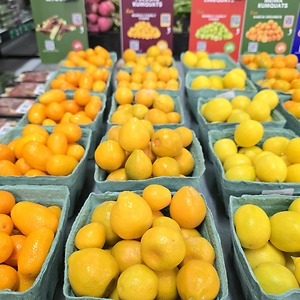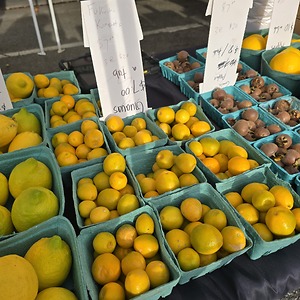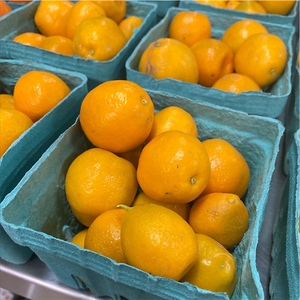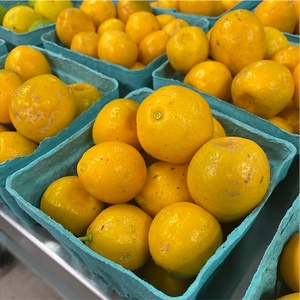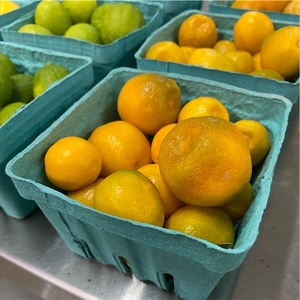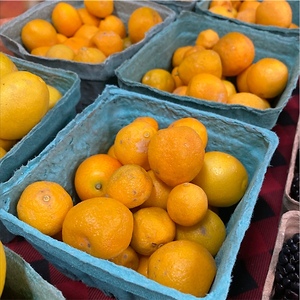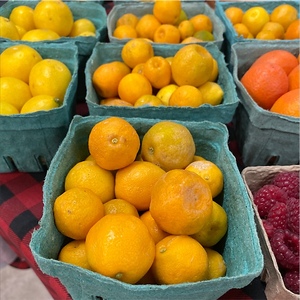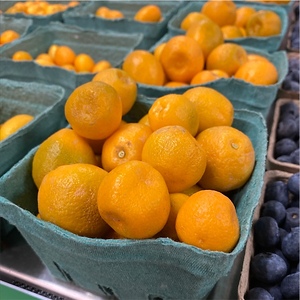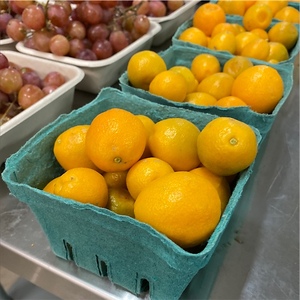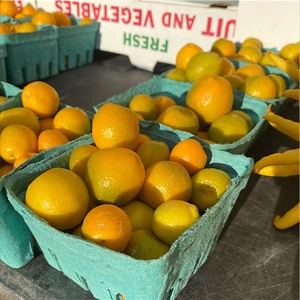

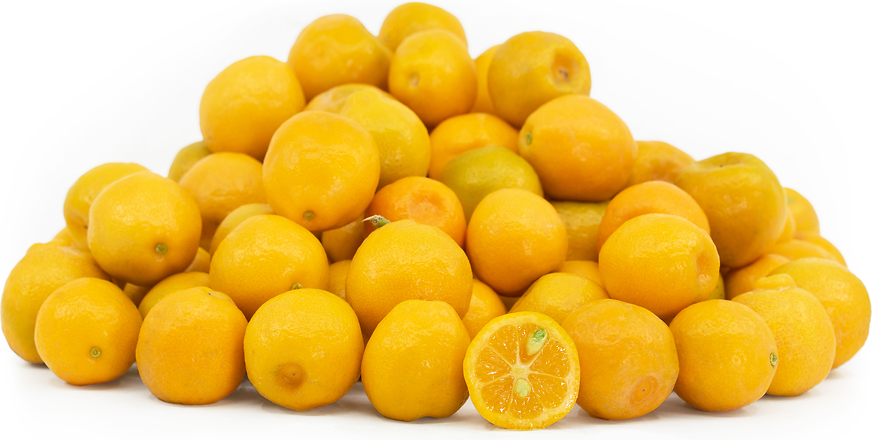
Fukushu Kumquats
Estimated Inventory, lb : 0
This item was last sold on : 03/22/25
Description/Taste
Fukushu kumquats are a larger variety, averaging 3 to 7 centimeters in diameter, and have a distinct round to oval, bell-shape with a slightly depressed apex. The rind is thin, glossy, and semi-smooth, covered in prominent oil glands, giving the surface a textured appearance. The rind also transitions from golden to dark orange as the fruits are left to naturally ripen on the tree. Underneath the surface, the flesh is thick, dense, and divided into 5 to 8 segments. The orange flesh also bears an aqueous, tender consistency, encasing a few large cream-colored seeds. Fukushu kumquats are entirely edible, including the rind and flesh, but many consumers choose to discard the seeds rather than ingesting. The rind has a sweet, sometimes acrid flavor mixed with a tart, acidic flesh, giving the fruits a tangy, sweet, and sharp, subtly fruity, floral flavor. In addition to the fruit and evergreen leaves, white fragrant flowers appear seasonally and traditionally bloom in the summer.
Seasons/Availability
Fukushu kumquats are available year-round, with a peak season in the winter.
Current Facts
Fukushu kumquats, botanically classified as Fortunella obovata, are a rare variety belonging to the Rutaceae or citrus family. The uniquely shaped species was created from a natural crossing in Japan and has a larger, rounder shape and broad, glossy leaves, favored for home gardens throughout China and Japan. When grown in the ground, the tree can reach up to three meters in height, but when grown in containers, the tree will exhibit a compact growth habit, allowing it to be cultivated on patios or in small spaces. Fukushu kumquats are less popular than the well-known nagami or meiwa cultivars, but the variety is known among citrus enthusiasts for its cold tolerance. In Asia, Fukushu kumquats are sometimes known as Changshou kumquats, Chojukinkan, Fuzhou kumquat, and Jiangsu, and are valued as a fresh eating cultivar for their sweet-tart, juicy flesh. Outside of Asia, Fukushu kumquats have remained a niche market citrus.
Nutritional Value
Fukushu kumquats, like other kumquat varieties, are an excellent source of vitamin C to strengthen the immune system, reduce inflammation, and boost collagen production within the skin. The fruits are also a good source of fiber to regulate the digestive tract, contain manganese, vitamin A, and calcium, and provide lower amounts of iron, zinc, potassium, vitamin E, and copper. Inside the sweet peel, essential oils such as limonene and flavonoids offer antioxidant and anti-inflammatory properties. In Traditional Chinese Medicine, Fukushu kumquats are also used as a remedy for sore throats, congestion, and coughs. The fruits are traditionally smashed, mixed with ginger, salt, and honey, and steeped as a soothing tea, or they are chewed and swallowed raw.
Applications
Fukushu kumquats have thick flesh and a sweet-tart flavor well suited for various culinary preparations and mixology uses. The peel and flesh are edible and can be washed and consumed whole as a snack, typically discarding the seeds. Fukushu kumquats can also be sliced and tossed into salads, chopped into salsa, mixed into yogurt, or pickled to develop a tangy, subtly sweet flavor. Once pickled, the fruits can be sliced and layered over avocado toast, mixed into salads and grain bowls, or served with seafood and meats. Beyond fresh preparations, Fukushu kumquats can be cooked into jellies, jams, marmalade, and chutney, blended into purees, infused into vinaigrettes, sauces, and syrups, or baked into muffins, cakes, scones, and other pastries. The fruits can also be candied as a sweet treat or used to flavor tea, wine, and cocktails. Fukushu kumquats pair well with meats such as poultry, turkey, pork, and duck, seafood, fruits including pears, pineapple, blueberries, cranberries, and raspberries, bitter greens such as arugula and endive, honey, chocolate, and herbs such as mint, rosemary, and basil. Whole, unwashed Fukushu kumquats will keep 1 to 2 weeks when stored in a plastic bag in the refrigerator's crisper drawer.
Ethnic/Cultural Info
In the coastal town of Cam Ha, Vietnam, a kumquat festival marks the beginning of Tet, also known as the Lunar New Year celebration. During the festival, fresh kumquats of different varieties are displayed on intricately pruned dwarf trees as a part of a public art exhibition. The trees are also judged by a panel of experts to determine which crafted plant will take home the highest honor and award for best in show. The kumquat festival also features local growers selling fresh golden fruits and food vendors promoting hand-crafted jellies, jams, wine, tea, candies, and pickled fruits. Historically, kumquats were viewed as a symbol of good luck and prosperity throughout Tet festivities and were a favored home decoration in Vietnam. Households traditionally purchased small trees that showcase flowers, buds, fruits, and glossy leaves. Each part of the kumquat tree represents a familial generation, with the fruits symbolizing grandparents, the flowers parents, the green buds as children, and the leaves as grandchildren. Smaller versions of kumquat trees, known as kumquat bonsai, are also given as gifts to friends and family as a blessing for good fortune.
Geography/History
Kumquats are native to Asia, specifically China, Japan, and select regions of Southeast Asia. The small fruits have been growing wild since ancient times and were extensively cultivated to showcase improved growth characteristics, tree size, and flavor. Fukushu kumquats are believed by experts to be a chance hybrid between two unknown kumquats and were first scientifically classified in Japan by Japanese botanist Tyozaburo Tanaka. In 1864, English citrus collector Robert Fortune introduced kumquats to Europe and North America, reclassifying the fruits into the Fortunella species. Fukushu kumquats were donated to the Riverside Citrus Variety Collection in 1963 and have remained a specialty cultivar in the United States. Today Fukushu kumquats are widely available throughout Southeast Asia, Japan, and China and are found in home gardens of citrus enthusiasts in the United States and Europe.
Recipe Ideas
Recipes that include Fukushu Kumquats. One
| Susan Can Cook |
|
Fukushu Kumquat Marmalade |



